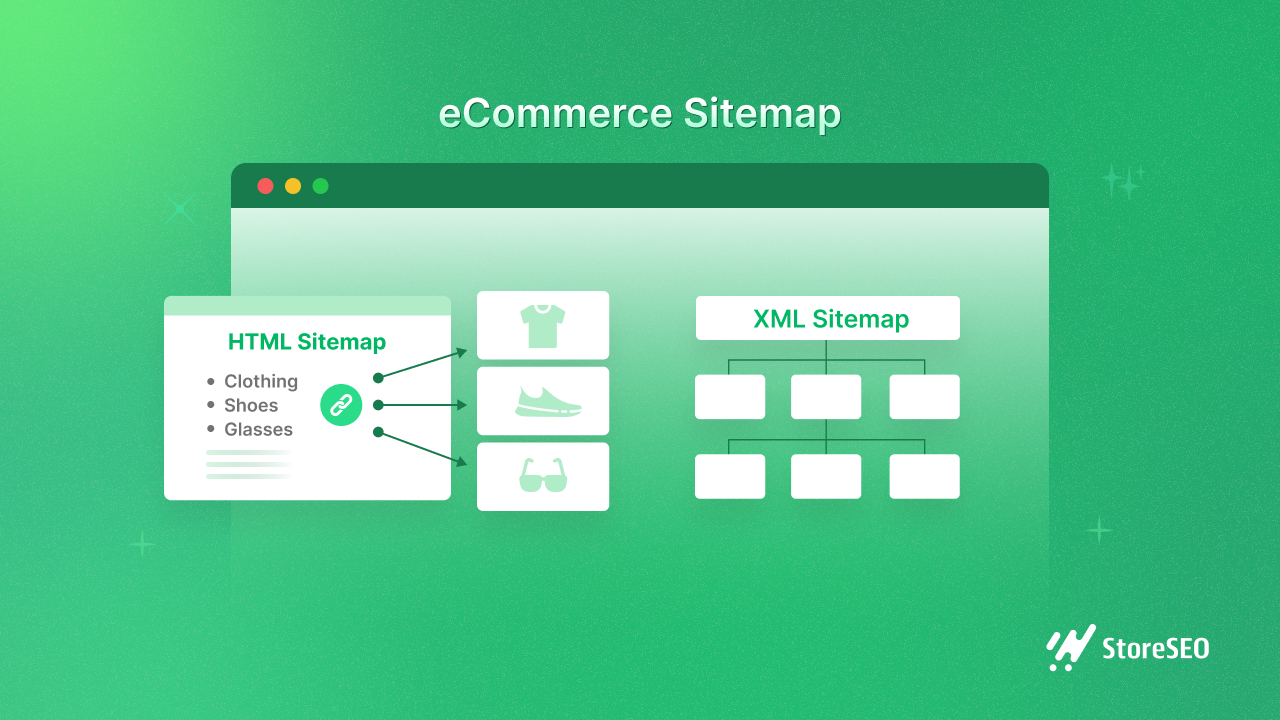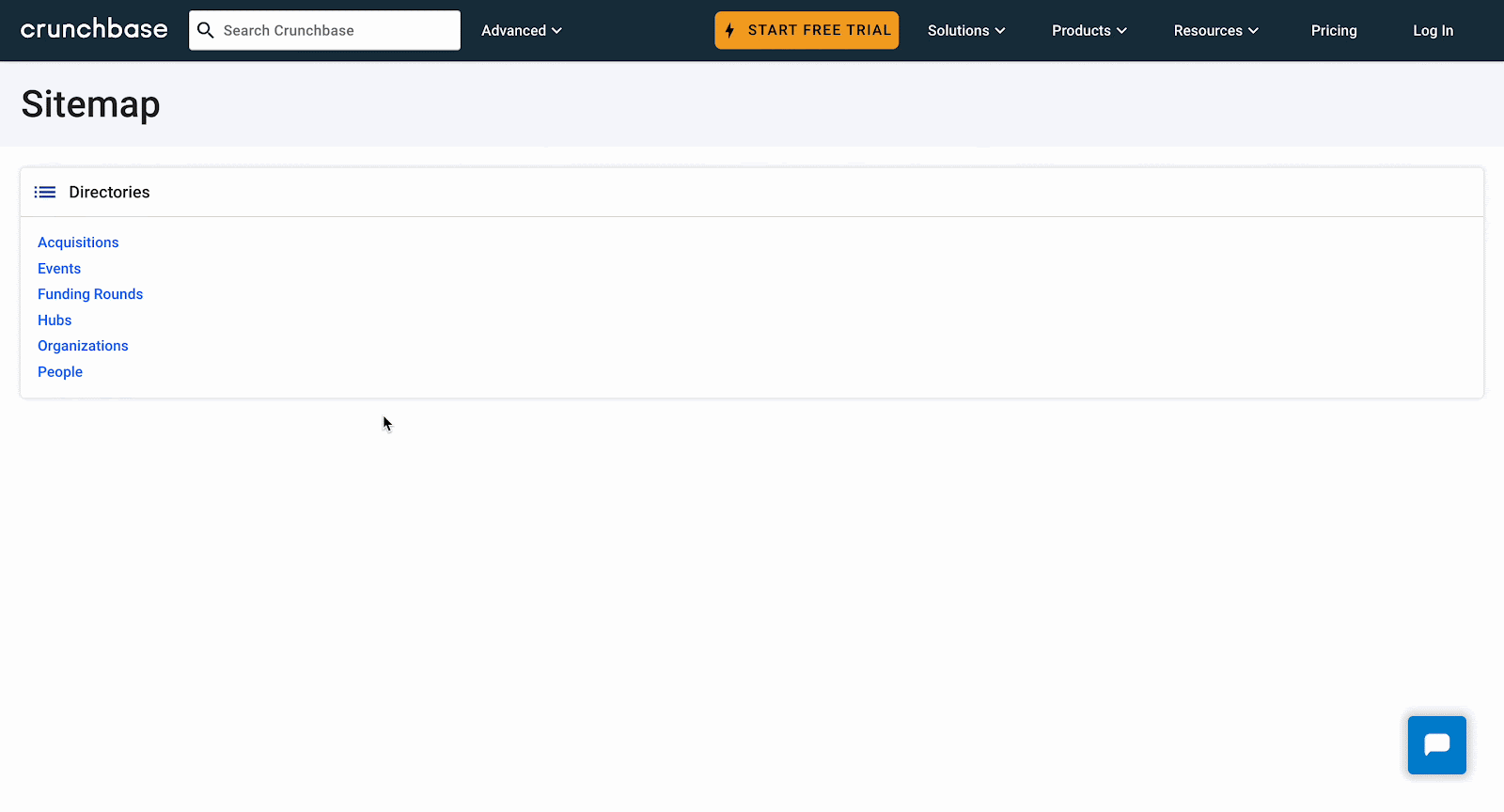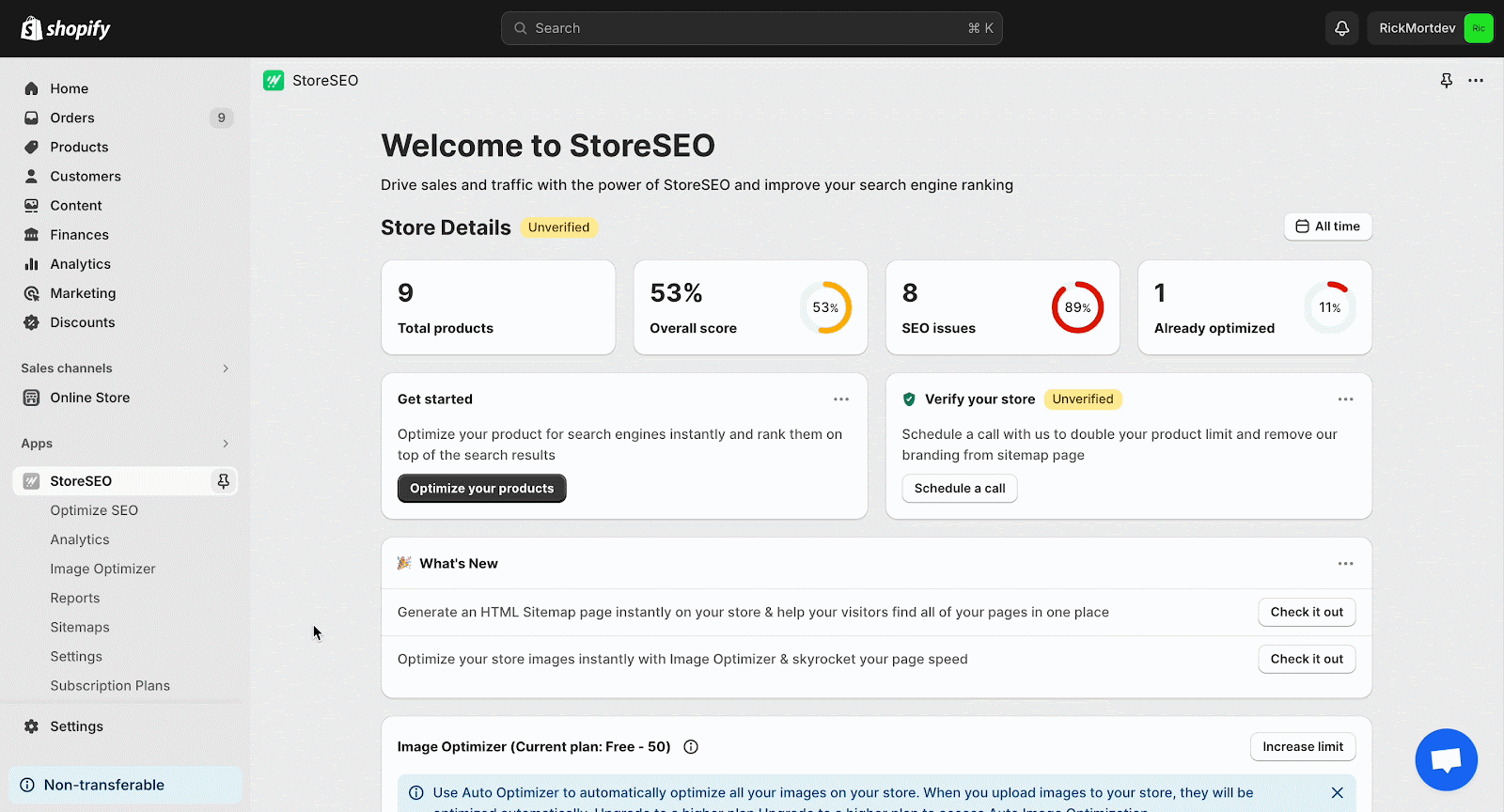El Mapa del sitio de comercio electrónico Ayuda a mejorar la capacidad de rastreo y la indexación de su tienda para atraer tráfico orgánico. Si tiene una gran tienda de comercio electrónico, un mapa del sitio puede ser la clave definitiva para el éxito en el juego de SEO. En este blog, analizaremos los pros y los contras de los mapas de sitios de comercio electrónico. Así que, sin más preámbulos, comencemos.

¿Qué es un mapa del sitio de comercio electrónico?
Un mapa del sitio de comercio electrónico es el mapa de su tienda de comercio electrónico. Ayuda a los rastreadores de motores de búsqueda a encontrar y comprender sus páginas web. Básicamente, es una estructura del sitio web que contiene todas las diferentes páginas, categorías y productos disponibles en su tienda. Por lo tanto, los rastreadores de motores de búsqueda pueden descubrir fácilmente todas las páginas a través de este mapa.
Tipos de mapas de sitio para tiendas de comercio electrónico
Los mapas de sitio se clasifican principalmente en dos tipos: mapas de sitio XML y mapas de sitio HTML. A continuación, encontrará más detalles sobre estos mapas de sitio.
Mapa del sitio XML
El Mapa del sitio XML es un mapa que permite a los rastreadores de búsqueda encontrar y comprender todas sus páginas web. Contiene una lista de todas las URL de las páginas de su sitio web de forma estructurada.
Mapa del sitio HTML
El Mapa del sitio HTML Está diseñado específicamente para los visitantes de un sitio web. Ayuda a encontrar todas las páginas de un sitio web en un solo lugar.
Mapa del sitio de comercio electrónico XML frente a HTML
| Punto de comparación | Mapa del sitio de comercio electrónico XML | Mapa del sitio de comercio electrónico HTML |
| Objetivo | Diseñado para motores de búsqueda | Diseñado para humanos |
| Contenido | Metadatos sobre las páginas web, como su importancia, frecuencia de actualización y relación con otras URL dentro del sitio. | Concéntrese en proporcionar una experiencia de navegación fácil de usar organizando los enlaces de forma jerárquica y categórica. |
| Caso de uso | Ayuda en el proceso de indexación para diferentes motores de búsqueda y mejora la visibilidad del sitio web en los resultados de búsqueda. | Sirve como un mapa fácil de usar para que los visitantes encuentren rápidamente páginas o productos específicos desde una sola página. |
Otros tipos de mapas de sitio utilizados en tiendas de comercio electrónico
Anteriormente hemos analizado los dos tipos principales de mapas de sitio. Sin embargo, además de estos, existen otros tres tipos que se utilizan habitualmente en las tiendas de comercio electrónico. Profundicemos en ellos a continuación y exploremos estos mapas de sitio con más detalle.
TXT(texto) Mapa del sitio
El mapa del sitio TXT (texto) es un archivo de texto sencillo que contiene una lista de todas las URL de sus páginas en formato de texto sin formato. A diferencia de los mapas del sitio XML, los mapas del sitio TXT no ofrecen tantos detalles para los rastreadores de los motores de búsqueda.
Mapa del sitio de imágenes
Un mapa de sitio de imágenes es otro tipo de mapa de sitio XML que ayuda a los motores de búsqueda a rastrear imágenes en su sitio web. Contiene etiquetas HTML para identificar imágenes específicas y ayudar a los rastreadores a comprender su sitio web.
Mapas de sitios de vídeo
El Mapa del sitio de videos Proporciona información adicional sobre los vídeos que aloja en su sitio web. Ayuda a los rastreadores de los motores de búsqueda a comprender y encontrar el contenido de vídeo de su sitio web al proporcionar información adicional, como el título del vídeo, la descripción, la duración y las imágenes en miniatura.
¿Cuál es el mejor formato de mapa del sitio para el comercio electrónico?
Entre los distintos tipos de mapas de sitio, el mapa de sitio XML es la mejor opción para los sitios web de comercio electrónico. Si tiene un sitio web de comercio electrónico grande, un mapa de sitio XML puede ayudar a los rastreadores de los motores de búsqueda a encontrar todas sus páginas con facilidad.
Además, un mapa del sitio HTML es una gran incorporación a las tiendas de comercio electrónico. Cuando tienes muchas categorías y páginas en tu tienda, un mapa del sitio HTML puede ayudarte a reunir todas esas páginas y categorías en un solo lugar. De esta manera, tus visitantes pueden encontrar fácilmente cualquier página en particular que estén buscando.
Qué incluye un mapa del sitio de comercio electrónico
El mapa del sitio de comercio electrónico incluye información sobre su sitio web de manera estructurada. Incluye las URL de su sitio web en el … etiqueta. Es la etiqueta principal de las URL de su sitio web donde puede agregar más información a través de etiquetas secundarias.
En el mapa del sitio de comercio electrónico, el La etiqueta se utiliza para especificar las URL canónicas. Además, la La etiqueta incluye la información de la modificación de la página. Asimismo, puedes utilizar etiquetas como y para especificar la prioridad y la frecuencia de actualización de cada página para ayudar a los motores de búsqueda a comprender mejor sus páginas. Vea el siguiente ejemplo de mapa de sitio de comercio electrónico en formato XML.

¿Cómo ayuda el mapa del sitio al SEO de una tienda de comercio electrónico?
Los mapas de sitio ayudan al SEO de las tiendas de comercio electrónico al garantizar una navegación y una capacidad de rastreo eficientes para el motor de búsqueda y los visitantes. Veamos en profundidad los beneficios de los mapas de sitio a continuación.
Mejore la experiencia del usuario y la navegación
Un sitio web de comercio electrónico incluye toneladas de enlaces y páginas diferentes. Los visitantes pueden perderse fácilmente entre ellos. Por lo tanto, cuando se trata de navegación y experiencia del usuario, un mapa del sitio de comercio electrónico puede resultar útil. Eche un vistazo a Sitio web de Crunchbase para ver cómo mantienen todos los enlaces organizados para una navegación sencilla.

Mejorar la capacidad de rastreo y la indexación
Un mapa del sitio proporciona a los robots de los motores de búsqueda una hoja de ruta de la estructura de su sitio web, lo que permite un descubrimiento y una navegación más eficientes de todas las páginas. Esto es especialmente útil para grandes plataformas de comercio electrónico con muchas categorías diferentes de productos y páginas. Cuando agrega todas las URL de su sitio web en el mapa del sitio, como listados de productos, directorios de categorías y páginas de destino clave, ayudará a los robots de los motores de búsqueda a rastrear su sitio web con facilidad.
Mantenga los enlaces internos y externos en un solo lugar
Cuando tienes millones de enlaces internos y externos en tu sitio de comercio electrónico, los rastreadores de los motores de búsqueda tendrán dificultades para rastrearlos todos. Con un mapa del sitio XML, puedes mantener fácilmente todos tus enlaces internos y externos en un solo lugar, lo que les permitirá comprender más fácilmente la estructura de tu sitio web para la indexación.
Configuración de prioridad y frecuencia de control
El mapa del sitio XML le permite establecer la prioridad y la frecuencia de actualización de cada página. Esto ayuda a los motores de búsqueda a determinar la importancia de las distintas páginas y la frecuencia con la que deben rastrearse para obtener actualizaciones. Por ejemplo, puede priorizar las páginas de productos sobre otras páginas menos importantes.
La mejor manera de crear un mapa del sitio de comercio electrónico para Shopify
En esta sección, te guiaremos sobre cómo puedes crear mapas de sitio de comercio electrónico para tu tienda Shopify. Sigue los pasos a continuación para generar mapas de sitio para tu tienda.
Cómo crear un mapa del sitio XML en Shopify
Shopify genera automáticamente un mapa del sitio XML para tu tienda. Por lo tanto, no tienes que crear un mapa del sitio XML para tu tienda. Para encontrar tu mapa del sitio, debes agregar “/sitemap.xml” al final de la URL de tu tienda y visitar el enlace. Dado que es un mapa del sitio generado automáticamente, necesitarás un generador de mapas del sitio de Shopify como StoreSEO para Editar o actualizar su mapa del sitio.
Cómo crear un mapa del sitio HTML en Shopify
Los mapas de sitio HTML mejoran la experiencia del usuario para sus visitantes. La aplicación StoreSEO puede ayudarlo a crear mapas de sitio HTML en Shopify de forma gratuita. Siga los pasos a continuación para crear un mapa de sitio HTML. Mapa del sitio HTML para Shopify víveres.
Paso 1: Instala StoreSEO en tu tienda
En primer lugar, usted Instalar StoreSEO En tu tienda Shopify. Busca StoreSEO en la tienda de aplicaciones e instálalo en tu tienda.

Paso 2: Generar un mapa del sitio para Shopify
Una vez que haya instalado StoreSEO, vaya al mapa del sitio HTML y haga clic en 'Generar' botón. Eso es todo, así es como puedes generar fácilmente un mapa del sitio en Shopify con StoreSEO. Ahora, puedes copiar la URL de tu mapa del sitio HTML desde allí y agregar este enlace donde quieras. Si quieres aprender paso a paso, puedes leer este documentación.

En caso de que utilices otras plataformas de comercio electrónico
¿Tienes un sitio web de comercio electrónico en otras plataformas? En ese caso, puedes leer el siguiente tutorial rápido para crear tu mapa del sitio.
Cómo crear un mapa del sitio en WooCommerce (WordPress)
Para WooCommerce, puedes crear fácilmente tu mapa del sitio con un complemento de SEO como Rank Math. A continuación, te indicamos cómo puedes crear un mapa del sitio en WordPress:
- Instale y active Rank Math en su sitio web.
- Vaya a la configuración del complemento y habilite los mapas de sitio XML.
- El complemento generará automáticamente un mapa del sitio para su tienda WooCommerce.
Cómo crear un mapa del sitio en BigCommerce
BigCommerce genera y actualiza su mapa del sitio automáticamente. Una vez habilitado, no tendrá que preocuparse por el mapa del sitio. Aquí le ofrecemos un tutorial rápido:
- Inicie sesión en su panel de BigCommerce.
- Vaya a Configuración de la tienda → 'Escaparate'.
- En la sección Mapa del sitio XML, habilite el Mapa del sitio XML.
Cómo crear un mapa del sitio en Wix
La plataforma de creación de sitios web Wix genera automáticamente un mapa del sitio para tu sitio web. Aquí tienes un tutorial rápido sobre cómo enviar tu mapa del sitio:
- Inicia sesión en tu cuenta Wix.
- Vaya al panel de control de su sitio y haga clic en 'Posicionamiento en buscadores (SEO)' (en Marketing y SEO).
- Seleccionar 'Mapa del sitio' y luego haga clic en 'Enviar mapa del sitio.
Cómo crear un mapa del sitio en Squarespace
En Squarespace, también puedes crear un mapa del sitio fácilmente. A continuación, te indicamos cómo puedes crear un mapa del sitio en Squarespace:
- Inicia sesión en tu cuenta de Squarespace.
- Ir a 'Ajustes' → 'Avanzado' → 'Posicionamiento en buscadores (SEO)'.
- Desplácese hacia abajo hasta la sección Mapa del sitio y haga clic en 'Generar mapa del sitio' botón.
Cómo enviar un mapa del sitio en Google Search Console
Una vez que hayas creado un mapa del sitio para tu tienda, debes enviarlo a Google Search Console. Para tu tienda Shopify, puedes enviarlo manualmente a Google o usar la aplicación StoreSEO. Para enviar tu mapa del sitio, sigue el tutorial que se proporciona a continuación.
Cómo enviar un mapa del sitio manualmente
Si tienes suficientes conocimientos técnicos de SEO, puedes enviar tu mapa del sitio manualmente a Google Search Console. En primer lugar, debes Conecta tu tienda con Google Search Console manualmente y luego vaya a la pestaña del mapa del sitio en Google Search Console.
Ahora, ingrese la URL de su mapa del sitio y haga clic en 'Entregar'botón. Una vez que hayas conectado tu tienda, simplemente escribe "/mapa del sitio.xml" antes de pulsar el botón enviar.

Cómo enviar un mapa del sitio con StoreSEO
Si no tienes muchos conocimientos técnicos sobre SEO, puedes usar StoreSEO para enviar tu mapa del sitio. Tiene integración con Google Search Console, por lo que podrás enviar tu mapa del sitio a tu panel de control de Shopify.
Simplemente navegue hasta 'Ajustes' → 'Integración de Google y luego proporcione el permiso necesario simplemente haciendo clic en los botones. Así es como puede enviar fácilmente su mapa del sitio con StoreSEO. Puede leer Esta documentación para instrucciones paso a paso.

Cómo crear la URL del mapa del sitio: prácticas recomendadas
Como se mencionó anteriormente, Shopify crea mapas de sitio y URL automáticamente, por lo que no tiene que preocuparse por las mejores prácticas para la creación de URL de mapas de sitio. Estas son las pautas que debe seguir al generar una URL de mapa de sitio:
Utilice el dominio raíz
Coloque el mapa del sitio en el nivel raíz de su dominio (por ejemplo, https://www.example.com/sitemap.xml). Esto garantizará una fácil accesibilidad y estandarización en todos los motores de búsqueda.
Mejores prácticas para mapas de sitios de comercio electrónico: para maximizar los beneficios del SEO
Los mapas de sitio ayudan a mejorar el SEO a través de una mejor capacidad de rastreo. Funcionan como un mapa de su sitio web para los robots de los motores de búsqueda. En esta sección, compartiremos algunas de las mejores prácticas que debe seguir para maximizar los beneficios del SEO.
Actualización periódica del mapa del sitio
Si actualiza un mapa del sitio periódicamente, ayudará al rastreador a comprender los cambios que está realizando en su sitio web. A continuación, se indican los consejos que debe seguir y no debe seguir al actualizar un mapa del sitio.
| Dos | Qué no hacer |
| ⭐ Agrega tus nuevas páginas ⭐ Eliminar las páginas eliminadas ⭐ Asegúrate de actualizar la frecuencia y prioridad ⭐ Utilice las fechas de última modificación ⭐ Pruebe su mapa del sitio para mantenerlo libre de errores | ⭐ No utilices URL irrelevantes ni enlaces de contenido duplicado o de baja calidad ⭐ No olvides enviar los cambios ⭐ No hagas mal uso de la frecuencia y prioridad ⭐ No ignore la notificación de error |
Preguntas frecuentes
Antes de cerrar este artículo, nos gustaría responder algunas de las consultas más comunes que encontrarás en comunidades y foros.
¿Un mapa del sitio faltante o incompleto es malo para las tiendas de comercio electrónico?
Es posible que haya visto muchos debates sobre mapas de sitio incompletos o faltantes y probablemente esté buscando la respuesta correcta. Bueno, un mapa de sitio de comercio electrónico ayuda a los motores de búsqueda a descubrir sus páginas. Cuando tiene una tienda grande, los mapas de sitio garantizan una capacidad de rastreo adecuada para su tienda.
Sin embargo, si tienes una tienda pequeña, no es obligatorio que envíes un mapa del sitio. En cambio, es más importante que interconectes tus páginas para guiar a los rastreadores de los motores de búsqueda. En ese caso, debes vincular correctamente la navegación interna de tu página, las rutas de navegación o el pie de página para indexar esas páginas en Google.
Dicho esto, el mapa del sitio proporciona un mapa de su tienda para los robots de los motores de búsqueda. Ahorra el presupuesto de rastreo y ayuda a indexar sus páginas importantes más rápido. Por lo tanto, debe intentar utilizar mapas de sitio adecuados para su tienda de comercio electrónico.
¿Cómo encontrar el mapa del sitio XML de Shopify?
Puedes encontrar el mapa del sitio XML de la tienda Shopify agregando “/sitemap.xml” al nombre de dominio de tu tienda. Por ejemplo, si el dominio de tu tienda es “example.myshopify.com”, la URL de tu mapa del sitio XML sería “example.myshopify.com/sitemap.xml”.
¿Cuáles son algunas herramientas para crear un mapa del sitio de comercio electrónico?
Shopify cuenta con funciones integradas para generar mapas de sitio XML. Puedes usar herramientas como StoreSEO para actualizar tu mapa de sitio XML y generar un mapa de sitio HTML.
Mejore el SEO de su tienda Shopify con un mapa del sitio de comercio electrónico
El mapa del sitio de comercio electrónico es una forma eficaz de potenciar tus esfuerzos de SEO en Shopify. Al facilitar a los motores de búsqueda el rastreo e indexación de tu sitio, puedes mejorar la visibilidad de tu tienda y atraer más tráfico calificado a tus productos. Por lo tanto, no pases por alto la importancia de un mapa del sitio bien optimizado en tu estrategia de SEO en Shopify.
¿Te resultó útil este blog? Si es así, por favor, Suscríbete a nuestro blog para obtener más guías útiles, blogs y actualizaciones de Shopify.









